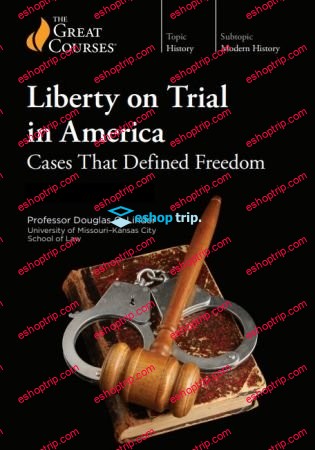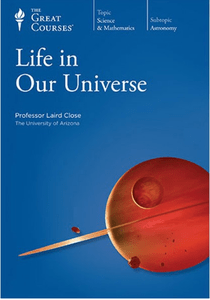Course No. 8692 | Lecturer: Douglas O. Linder, J.D. | + PDF Guidebook
We like to believe that the founding principle of the United States is liberty. “Give me liberty, or give me death!” Patrick Henry famously said in 1775 to encourage the Virginia colonists to fight for their freedom. It was liberty for which he was willing to sacrifice his life. And it was to gain that liberty that the colonists eventually fought and won the Revolutionary War. So, you would think that when the United States of America was formed, our citizenry could finally enjoy a plethora of hard-won liberties.
In 24 fascinating lectures, Professor Douglas O. Linder of the University of Missouri-Kansas City School of Law takes you behinds the scenes of the trials that brought us many of the freedoms we enjoy today. You’ll learn what happened when Anne Hutchinson dared to speak her religious ideas in the Massachusetts Bay Colony of the 1600s; when Susan B. Anthony decided to vote in a national election; when John Peter Zenger challenged colonial authorities in his newspaper; when labor activists promoted radical ideas in the 1880s in Chicago; when Jehovah’s Witnesses decided their children should not be forced to salute the American flag in school, and brought 22 other civil liberties cases to the courts, and more.
A Behind-the-Scenes Look
You’ll develop an in-depth understanding of the participants in more than 24 fascinating trials and learn what actions and thoughts led them to court, as well as hear from the prosecuting and defending attorneys in cases that addressed the freedom to:
Teach evolution. In 1925, John Scopes was a young science teacher who agreed to serve as a test case for the Tennessee Butler Act, the law that made it illegal to teach anything that denied the Biblical account of human origins. While Scopes was convicted of teaching evolution, the trial brought the issue into American homes. The Butler Act was repealed, but not until 1967.
Marry the person you love, no matter their skin color. When Richard Loving married Mildred Jeter in 1958, they were thrilled, but the commonwealth of Virginia was not; Richard was white, and the state identified Mildred as “colored,” which made it illegal for them to marry. They eventually took their case to the Supreme Court and won in 1967.
Defend your home and family, regardless of race. In 1925, African American doctor Ossie Sweet bought a home for his family in a white neighborhood of Detroit. When a white man was killed during a riot outside his house, police charged everyone in the Sweet home with premeditated murder. With Clarence Darrow as his lawyer, the Sweets won the same right to defend their property that their white neighbors already enjoyed.
Famous Figures
Many famous figures in American history play prominent roles in these trials, whether as plaintiff, defendant, or attorney. You’re familiar with their names, but in this course, you’ll learn their fascinating backstories, including:
John Brown, the abolitionist who armed slaves and encouraged an uprising in 1859 at Harper’s Ferry;
Susan B. Anthony, the women’s suffrage advocate who was arrested in 1872 for the act of voting;
Clarence Darrow, the attorney who, in the 1920s, defended the right of science teacher John Scopes to teach evolution in public school, and—with a seven-hour summation—defended the right of African American Henry Sweet to defend himself against a white mob;
William Jennings Bryan, three-time presidential candidate, U.S. Secretary of State, and the attorney who prosecuted John Scopes for teaching evolution in public school, but withered under examination by Clarence Darrow;
Norma McCorvey (“Roe”), the woman who filed suit against Dallas District Attorney Henry Wade in 1970, challenging a Texas law that prohibited her from having an abortion; and
Jack Kevorkian, the doctor who advocated for a patient’s right to die by physician-assisted suicide, participated in euthanasia, and was convicted of murder in 1999.
When Liberty Lost
U.S. history has not always moved in a straight line from less freedom to more freedom. In Liberty on Trial in America: Cases That Defined Freedom, you’ll learn not only about cases in which liberty claims were vindicated, but also those in which they were denied. Sometimes those cases that upheld the status quo seem most clearly unjust by today’s standards, and, occasionally, even by the standards of the times. Slavery, for example, sometimes received protection by judges who nonetheless found it despicable. It was the Civil War and the Fourteenth Amendment, not the courts, that finally granted liberties to enslaved persons. You’ll learn about cases that:
Did not allow a slave to testify that she killed her master in self-defense after he had repeatedly raped her over a period of years. At trial, evidence was presented that the fatal blow that particular night came only after Celia (no last name) was physically threatened, but the judge instructed the jury to ignore that evidence. Celia was convicted and executed.
Upheld the “separate but equal” doctrine, keeping Jim Crow laws on the books for decades. Homer Plessy was a Caucasian-looking man in Louisiana who took a seat in a train’s “white” section, announced he was 1/8 African American, and refused to move. The case eventually reached the Supreme Court, which upheld the constitutionality of racial segregation laws for public facilities.
Upheld the constitutionality of the Japanese American relocation camps on the basis of national security. Two months after Pearl Harbor, President Roosevelt signed an executive order requiring all Japanese Americans to move into the camps. Fred Korematsu refused, was arrested, convicted, and took his case to the Supreme Court. The Court majority found that the executive order was justified by national security concerns.
No courts are infallible. As you’ll learn in Liberty on Trial in America: Cases That Defined Freedom, the Supreme Court has come back to revisit these and many other decisions. Sometimes new information is available, or the social framework of society has drastically changed, and sometimes the original decisions were just wrong. For example, in 2018, Chief Justice John Roberts took an opportunity to comment on Korematsu: “Korematsu was gravely wrong the day it was decided, has been overruled in the court of history, and—to be clear—has no place in law under the Constitution.”
As you learn about the intriguing cases presented in the 24 lectures of this course, you’ll understand and appreciate your own liberties in a new way. After all, every freedom we have has been won through someone’s passion and willingness to fight for what they believe is right. And just as liberty has been continuously redefined throughout American history—it will continue to be redefined in the future.











Reviews
There are no reviews yet.